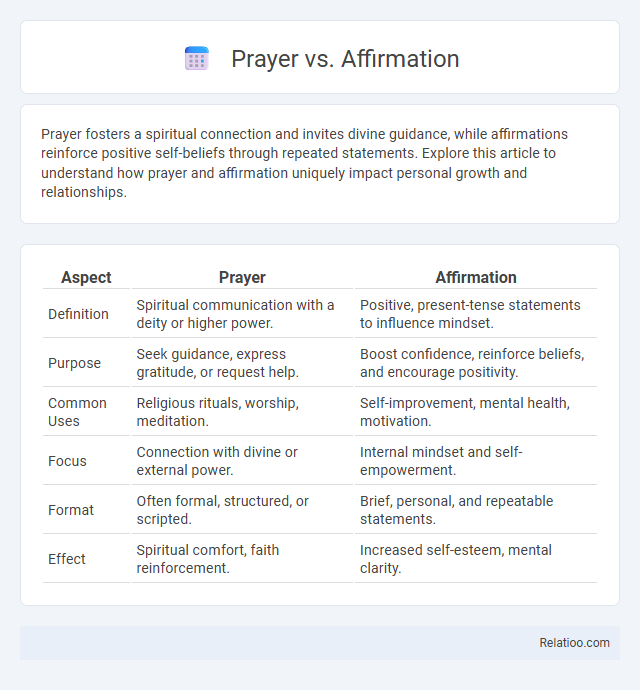Prayer fosters a spiritual connection and invites divine guidance, while affirmations reinforce positive self-beliefs through repeated statements. Explore this article to understand how prayer and affirmation uniquely impact personal growth and relationships.
Table of Comparison
| Aspect | Prayer | Affirmation |
|---|---|---|
| Definition | Spiritual communication with a deity or higher power. | Positive, present-tense statements to influence mindset. |
| Purpose | Seek guidance, express gratitude, or request help. | Boost confidence, reinforce beliefs, and encourage positivity. |
| Common Uses | Religious rituals, worship, meditation. | Self-improvement, mental health, motivation. |
| Focus | Connection with divine or external power. | Internal mindset and self-empowerment. |
| Format | Often formal, structured, or scripted. | Brief, personal, and repeatable statements. |
| Effect | Spiritual comfort, faith reinforcement. | Increased self-esteem, mental clarity. |
Understanding Prayer and Affirmation
Prayer involves a spiritual communication with a higher power, seeking guidance, support, or expressing gratitude, often rooted in religious or faith-based traditions. Affirmations are positive, declarative statements designed to reprogram the subconscious mind and reinforce self-belief, typically used in personal development and psychology. Understanding the difference highlights that prayer is dialogical and relational, while affirmations are self-empowering tools aimed at mental conditioning and motivation.
Historical Roots and Spiritual Context
Prayer, rooted in ancient religious traditions, serves as a direct communication with a divine entity, often seeking guidance, forgiveness, or blessings within a spiritual context. Affirmations emerged more recently from psychological and self-help movements, emphasizing positive self-statements to influence the subconscious mind and promote mental well-being without invoking a deity. Understanding the historical roots and spiritual context of these practices helps you choose between invoking a higher power through prayer or fostering personal empowerment through affirmations.
Defining Prayer: Purpose and Practice
Prayer serves as a spiritual communication with a higher power, offering a purposeful practice for seeking guidance, expressing gratitude, or requesting support. Unlike affirmations, which involve self-empowering statements to influence subconscious beliefs, prayer centers on faith and connection beyond the self. Your prayer practice cultivates mindfulness, spiritual growth, and emotional comfort through intentional reflection and devotion.
What Are Affirmations? Foundations and Goals
Affirmations are positive, declarative statements designed to reprogram your subconscious mind and reinforce empowering beliefs. Rooted in psychological principles, their goal is to boost confidence, reduce negative self-talk, and manifest desired outcomes through repetition. Unlike prayer, which often involves seeking external guidance or intervention, affirmations focus on self-empowerment and internal mindset transformation.
Key Differences Between Prayer and Affirmation
Prayer involves communicating with a higher power, often seeking guidance, support, or expressing gratitude, while affirmation is a positive statement you repeat to yourself to influence your mindset and behavior. Prayer is typically rooted in faith and spirituality, reflecting a relational aspect with the divine, whereas affirmation is a psychological tool aimed at reinforcing self-belief and motivation. Understanding these key differences helps you choose the practice that aligns best with your personal growth and spiritual needs.
Psychological Impact: Prayer vs Affirmation
Prayer often provides psychological comfort through a sense of connection to a higher power, promoting emotional resilience and reducing stress by fostering hope and spiritual support. Affirmations enhance psychological well-being by reinforcing positive self-beliefs, improving self-esteem, and reducing negative thought patterns through consistent, conscious repetition. Both techniques engage cognitive processes that influence mental health, yet prayer emphasizes external faith-based reassurance while affirmations focus on internal cognitive restructuring.
Spiritual Perspectives on Both Practices
Prayer and affirmation both serve as powerful spiritual tools but differ fundamentally in their approach and focus. Prayer is centered on divine communication, often seeking guidance, support, or intervention from a higher power, reflecting faith and surrender. Affirmations emphasize self-empowerment and positive mindset shifts, using repetitive statements to reprogram subconscious beliefs and align personal energy with desired outcomes.
Common Misconceptions Clarified
Prayer is often misunderstood as solely asking for favors, but it primarily serves as a spiritual dialogue enhancing your connection with the divine. Affirmations are positive statements aimed at reprogramming subconscious beliefs to influence behavior and mindset, not invoking a higher power. Many confuse affirmation with prayer, but clarifying these distinctions helps you choose the practice that aligns best with your personal growth and spiritual goals.
Integrating Prayer and Affirmation in Daily Life
Integrating prayer and affirmation in daily life enhances spiritual and mental well-being by combining heartfelt communication with positive self-empowerment techniques. You can create a balanced routine by dedicating moments to express gratitude and seek guidance through prayer, while reinforcing confidence and intention with daily affirmations. This holistic approach nurtures resilience, mindfulness, and a deeper connection to your inner values and goals.
Choosing What Works Best for You
Prayer offers spiritual connection and comfort by communicating with a higher power, while affirmations use positive self-statements to reinforce confidence and mindset. Choosing what works best depends on personal beliefs, goals, and emotional needs; some individuals find combining prayer with affirmations enhances both faith and motivation. Experimenting with each method helps identify the most effective approach for mental clarity, emotional resilience, and overall well-being.

Infographic: Prayer vs Affirmation
 relatioo.com
relatioo.com